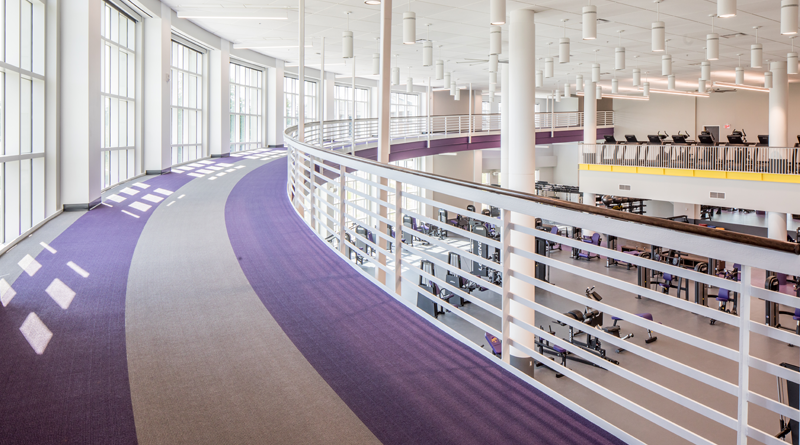Five Design Considerations for Campus Recreation Centers
By Steve Griffin and Jim Gilliam
Designing a school’s recreation center or gym is an important undertaking. When students and parents weigh their choice of schools, a well-designed rec center or gym can impact where they choose to begin their journey, and schools often use these facilities as part of their recruitment efforts.
Outside of being an asset to students, campus recreation and fitness centers can serve as spaces for community members to participate in wellness activities, which extends the rec center’s value beyond students. While there are many ways to successfully design and construct rec centers and gyms for a school or university, keep these five considerations top-of-mind during the process to ensure the best outcome.
1. Take advantage of purchasing cooperatives
Many government or municipal entities have access to purchasing co-ops, or pre-made arrangements to buy products in bulk, ultimately enhancing overall purchasing power. These co-ops make buying materials significantly more accessible and expedite the delivery timeline for everything from early childhood centers to state-run higher education institutions.
Since purchasing co-ops have already completed and won the bidding processes, the materials bidding step is eliminated, saving time, effort and usually cost. Purchasing co-ops offer resources and purchasing plans to entities through specific special item numbers (SINs) for a variety of desired items, from sport surfaces to park playground equipment and systems.
2. Plan early for pedestrian and vehicular transportation
Designers must plan for pedestrian congestion in addition to car, bus and shuttle traffic when developing recreation centers for school campuses, especially at the higher-ed levels. Early coordination is essential for the ingress and egress planning around crowded campus areas, and architects should communicate with civil engineers as early as possible to ensure safe and efficient routes.
Keeping pedestrian walkways and roadway vehicles separated helps best protect students on-foot and mitigate accidents. Ensure all necessary stakeholders are involved in design conversations from the project’s beginning to address different safety scenarios and develop potential solutions.
3. Ensure enough floor-to-ceiling and floor-to-floor height
Since today’s recreation centers have more functions and amenities than standard spaces, ensuring enough floor-to-ceiling and floor-to-floor height is critical. In kinetic spaces like gyms, retractable goals and nets are common to create easy storage and multi-use spaces, utilizing the additional floor-to-ceiling height. For example, Elk River High School has eight suspending basketball goals and two suspending volleyball nets that allow greater flexibility in the gym and maximize the space.
Floor-to-floor height is the distance from the top of one walkable floor to the top of the next, including ceiling and floor depths and various systems. The proper distance guarantees enough room above the ceiling to comfortably and efficiently install necessary systems, including HVAC, electrical, mechanical and air ducts, while creating a flexible, versatile space to accommodate a variety of student and community needs.
It’s especially vital to prioritize HVAC systems in fitness or recreation centers to maintain fresh air and alleviate humidity (think: sweating, indoor pools, showers, saunas and so on). The HVAC systems for rec centers should be different from the rest of the building. For example, Tennessee Tech University’s Marc. L Burnett Recreation Center isolated the pool from the rest of the building so it could have its parameters for controlling humidity.
4. Incorporate multiple multi-purpose rooms when possible
There’s no “one-size-fits-all” approach when designing multiple rooms within a single facility. Incorporate various multi-purpose rooms to accommodate a variety of students and users participating in different activities. Where possible, include at least one small (10-15 people), medium (20-30) and large (100+) multi-purpose room within the gym or building’s design. These adaptable rooms allow for easy separation and more opportunities for different classes and uses.
Dance studios, wellness and nutrition areas, classrooms and training rooms can all make a facility stand out and cater to different physical activity levels. Mound Westonka High School’s Activity Center was designed to include three full-size courts, an elevated walking track, fitness room, cardio room, wrestling gym and community meeting room to provide space for the community to gather in addition to extra practice space for the school’s numerous athletic programs.
5. Creatively incorporate school branding
Recreation and fitness centers are typically included in college recruitment tours and are often seen as a differentiator for schools. These spaces represent health, community and quality of life. Showcase the school’s branding such as mascots and colors to convey school spirit and a sense of pride in the facility.
School logos and colors can also be featured in multi-court gym flooring, trim and wall colors in fitness centers, pool lane ropes or logo stair riser decals on facility steps. Mound Westonka High School incorporated its school colors throughout its activity center, from the walls of the courts to the padding on the wrestling room floor. At Tennessee Tech University, the campus’ existing Georgian Style of architecture was incorporated into elements of its recreation center, blending the new facility into the overall aesthetic of the university.
Fitness and recreation centers are an important way to differentiate schools or universities while creating a space for students and community members to invest in their health and well-being. In many instances, these spaces strengthen communities by bringing various stakeholders together, ultimately improving the lives of those on campus and far beyond.
Steve Griffin, AIA, and Jim Gilliam, PE, are principals at Brentwood, Tenn.-based Wold | HFR Design and can be reached at SGriffin@hfrdesign.com and JGilliam@hfrdesign.com.

